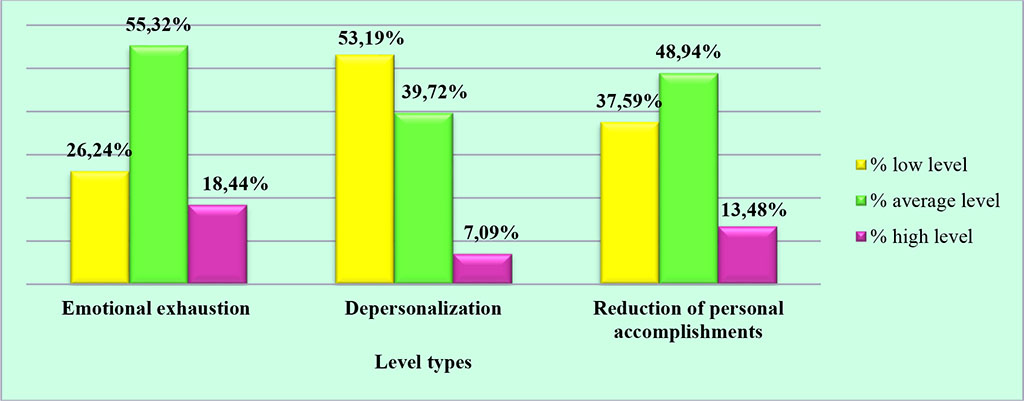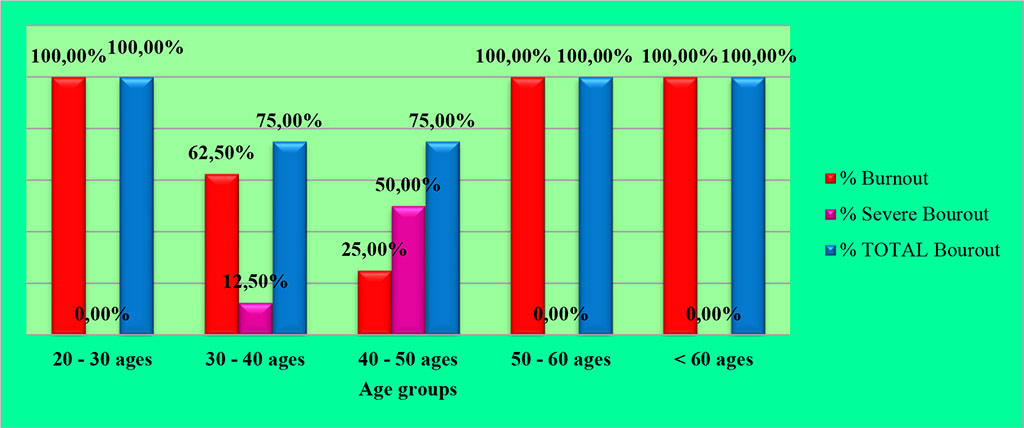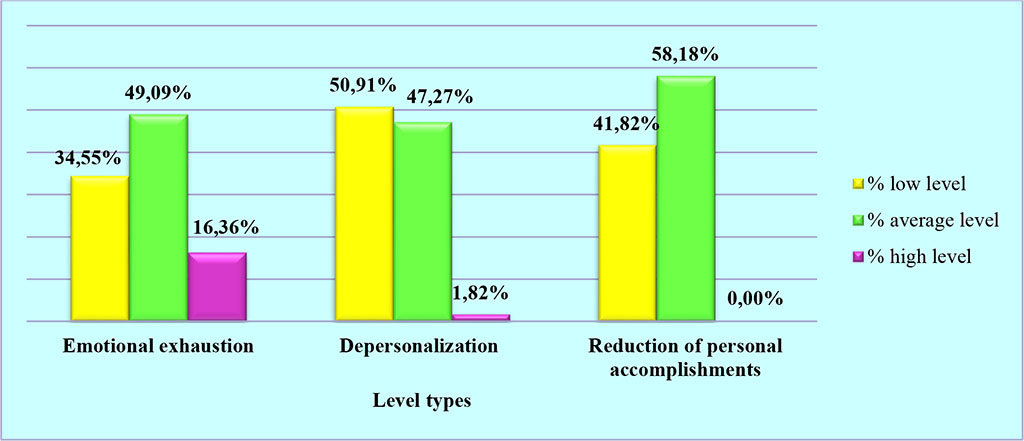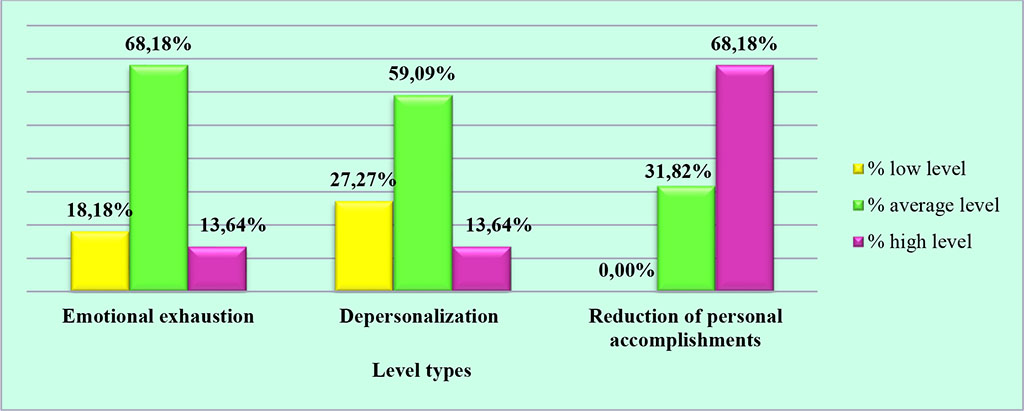- Home
- About the Journal
- Peer Review
- Editorial Board
- For Authors
- Reviewer Recognition
- Archive
- Contact
- Impressum
- EWG e.V.
Scope: identification of burnout syndrome at the mentioned medical personnel and implementation of some measures to reduce its effects.
The study had been prospective, performed in the period between February and April 2019 on a sample of 180 subjects comprising AIC (Anesthesia & Intensive Care) physicians, nurse anesthetists, nurses, and healthcare assistants from ICU and from the surgical unit within Emergency Clinical Hospital of Galati. MBI (Maslach Burnout Inventory) survey, validated in Romanian, was self-administered to collect the data. 141 subjects responded out of 180, representing 78.33%. Out of these, a number of 99 subjects present burnout syndrome, respectively a percentage of 70.21%. As reported to the three components of the survey, 73.76% of the subjects present emotional exhaustion at medium and high levels, 46.81% present depersonalization and 62.42% present personal accomplishments’ reduction. According to the professional categories, the highest stress level is registered at the ICU healthcare assistants with 100% burnout, followed by AIC physicians with 80%, nurses and healthcare assistants from the Surgical Unit 64.45%, ICU nurses 61.29%, the “lowest” level being 55.56% for the nurses from Anesthesia Department. It must be noted the severe burnout level according to the profession: as per the emotional exhaustion level, AIC physicians are affected in a percentage of 33.33%, ICU nurses 19.5%, nurse anesthetists 16.67%, nurses from the Surgical Unit 16.36% and ICU healthcare assistants 13.64%.
In conclusion, this study shows that the most affected categories are the ICU healthcare assistants and AIC physicians, the physicians having the greatest level of emotional exhaustion, and the healthcare assistants the greatest level of personal accomplishment’s reduction.
Keywords: burnout, AIC, surgical unit, emotional exhaustion, personal accomplishment reduction.
Burnout syndrome has become a present-day reality, affecting various forms of social-professional categories and especially, professionals from medical area (Sandu, 2021a; 2021b; Sandu & Damian, 2018; Silistraru et al., 2021; Silistraru et al., 2022). The dictionary definition of the word: burn + out is total combustion, “psychic carbonization “. The term was borrowed from aero-spatial area: the depletion of fuel from a rocket having as consequence the reactor’s overheating and explosion (Lupu et al., 2017; Vendemmia et al., 2019). By analogy, burnout is characterized by physical and psychic exhaustion of a person which will consume all his/her energy and “collapse” (Langevin, 2018; Pascu et al., 2019).
The burnout syndrome’s stages are the following (Brunet, 1996; Lefebvre, 2004; Silistraru et al., 2021):
The study had been prospective, performed in the period between February and April 2019 on a sample of 180 subjects comprising AIC (Anesthesia & Intensive Care) physicians, nurse anesthetists, nurses and healthcare assistants from ICU (Intensive Care Unit) and from the SU (Surgical Unit) within Emergency Clinical Hospital of Galati.
MBI (Maslach Burnout Inventory) survey, validated in Romanian language, was self-administered in order to collect the data (Barad, 1979; Freudenberger, 1974; Maslach et al., 1997). Christine Maslach defines the burnout syndrome by three major elements (Demerouti & Bakker, 2007; Maslach, 1979; Mathe & Rogozea, 2013; Poncet, 2007):
The survey comprises 23 items and contains a series of questions with 5 variants of answer. It is calculated the sum of the points for each dimension, being obtained a score each. This score will be fit into one of the four intervals:
Summing up the last two intervals will be considered to determine total burnout.
141 subjects responded out of 180, representing 78.33%. Out of these, a number of 99 subjects present burnout syndrome, respectively a percentage of 70.21%.
According to the age groups (Figure 1), the highest percentage was registered at subjects between 30 and 40 years old (81.82%) and the lowest at those comprised between 20 and 30 years old (33.33%). Resident physicians and debutant nurses are included in this last category, which are guided in taking the decisions by experienced medical staff (primary physicians, senior nurses), relieving them somewhat by assuming total decisional responsibility.

Figure 1. Evaluation of burnout syndrome in AIC personnel per
age groups
Source: Authors' own conception
The evaluation according to the three components of the survey (Figure 2) shows that 73.76% of the subjects present emotional exhaustion at an average and high level, 46.81% depersonalization and 62.42% reduction of personal achievements.

Figure 2. Evaluation according to level types in AIC personnel
Source: Authors' own conception
Out of the data analysis (Figure 3), it results that a percentage of 80% from AIC physicians present burnout syndrome, the most affected being those comprised in the age group between 20 and 30 years old (100%) and those over 50 years old (100%), a lower-level belonging to those comprised between 30 and 50 years old (75%).

Figure 3. Evaluation of burnout syndrome in AIC physicians per
age groups
Source: Authors' own conception
The emotional exhaustion reaches the highest level in physicians (86.66%), followed by the reduction of personal achievements (73.33%) and depersonalization (46.67%).
Out of a total number of 18 nurses, 10 subjects present burnout syndrome, respectively 55.56%, the most affected age being the one comprised between 50 and 60 years old (Figure 5). It must be observed that the lowest percentage among all professional categories surveyed, probably due to the presence of the anesthesiologist in the surgery theatre and to the fact that the physician assumes responsibility for the decisions.
Emotional exhaustion (Figure 4) reaches the highest level in Anesthesia nurses (55.56%), followed by the reduction of personal accomplishments (27.78%), at equal value with depersonalization (27.78%).

Figure 4. Evaluation per level types in Anesthesia nurses
Source: Authors' own conception
This professional category is affected by burnout in a percentage of 65.45%, the emotional exhaustion being at the highest level (87.09%), followed by the reduction of personal accomplishments (58.07%) and depersonalization (35.48%) (Figure 5).

Figure 5. Evaluation of SU nurses and healthcare assistants
per level types
Source: Authors' own conception
The result of this study shows that healthcare assistants are the most affected professional category, 100% presenting this syndrome. The reduction of personal accomplishments was the component with the highest level recorded (100%) (Figure 6); this is most probably caused by conflictual interpersonal relations, no teamwork and deficient support to colleagues.

Figure 6. Evaluation of ICU healthcare nurses per level types
Source: Authors' own conception
The data from this study show a very high level of burnout syndrome in ICU and SU within Emergency Clinical Hospital of Galati, much more over the average level accepted by similar studies. The most affected personnel categories are AIC physicians and ICU healthcare assistants, the physicians having the most increased level of emotional exhaustion and the healthcare assistants with the most increased level of reduction of personal accomplishments.
As measures to be implemented over the average term, we can mention the supplementation with medical personnel from these two most affected categories, which might improve the existing problems. Also, psychologic counseling of the subjects, learning about and “training on” teamwork, collegial respect at language level and management – employee / employee – employee attitude, exercises of “team building” type, will succeed in soldering the interpersonal relations between them.